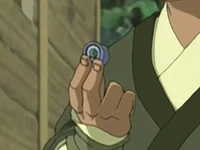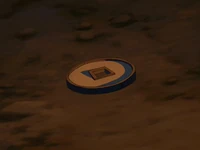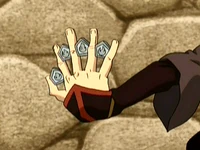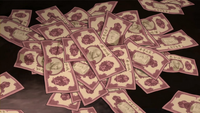The currency in the World of Avatar is primarily based on precious metals that denote differing values, usually gold, sliver, and copper. The same metals are typically used throughout all four nations, though coins are fashioned into different shapes and sizes dependent on their origin. Gold has the most value, and copper the least.[1]
After the Hundred Year War, paper money came into widespread use, most notably in the United Republic of Nations.[2]
Air Nomads
Some of the Air Nomads' activities involved trading in the currency of other nations. By selling their signature fruit pies for one silver piece each, the monks donated the profits to charity.[3]
Water Tribe

Water Tribe currency is blue in color.
Water Tribe money is blue and circular, with a hole through the center. This gives the currency a ring-like shape, and it seems to be thicker than an average coin.[4] Prior to the end of the Hundred Year War, the re-involvement of the Northern Water Tribe in international affairs, and the rebuilding of the Southern Tribe (which resulted in a larger presence on the world stage), the Water Tribes had a relatively primitive economy, largely based on subsistence. Therefore, their currency was not as advanced as those of more developed nations. Water Tribe money is accepted in certain parts of the Earth Kingdom, though some local areas, such as Chin Village, explicitly refuse to accept it (though it's not entirely clear why).[1][4]
By 171 AG, the yuan became an accepted form of currency in the Southern Water Tribe.[5]
Earth Kingdom
Earth Kingdom coins are mostly round, and all have a square hole in their center which allows them to be strung together. The shape of Earth Kingdom currency is the same as the nation's insignia. There is no significant difference between copper, silver, and gold pieces besides the materials of which they are made. The only notable difference is that in gold pieces, the borders are marked by a richer shade of gold.[6]

An Earth Kingdom copper piece is of the standard design for the nation: round, with a square hole in the center.
Copper piece
The copper piece is the coin with the least value in the Earth Kingdom;[7] it is a small circular copper coin with a square hole in the middle.[8][9]
Silver piece
A silver piece is an Earth Kingdom coin worth more than a copper piece, but less than a gold piece. It is made of silver and the second most valuable monetary item next to gold.
Gold piece
The gold piece is the most valuable coin in the Earth Kingdom. It is worth more than several copper and silver pieces put together.
Gold ingots
The Earth Kingdom also uses small ingots on rare occasions. They are small, oval-shaped lumps of gold, with a shape resembling a boat.
Fire Nation
Fire Nation coins are much more angular than their Earth Kingdom counterparts. They vary according to weight, size, and shape, though all have a nationalistic emblem on one side and writing on the opposite.[1]

Fire Nation currency bears the national insignia.
Copper piece
The copper piece is the least valuable coin in the Fire Nation, made of copper. It is a rectangle with two concave sides and a small image of a flame in its center.
Silver piece
The silver piece is the smallest coin in the Fire Nation. It is pentagonal in shape with the national emblem on its front.[10] Although small in size, it is the second most valuable coin in the Fire Nation.
Gold piece
The gold piece is the longest coin in the Fire Nation and is mostly rectangular in shape with a long slit running from its base to slightly below its top.[10] Consisting entirely of gold, these pieces are the most valuable coins in the Fire Nation.
United Republic of Nations

Yuan bills use mostly pink ink.
The United Republic of Nations' currency is called a yuan,[11] and denominations are available as both paper bills and metal coins. The paper bill features an image of Avatar Aang on the obverse and one of City Hall on the reverse.[12] The coins, which are worth one yuan each, are golden in color and exhibit three rectangles in their design.[13]
Trivia
- In the World of Avatar, it is the metal and not the currency itself that is valuable,[4] much as it was in many parts of the world before the adoption of the banknote. This is known as intrinsic value in numismatic circles. In the post-Hundred Year War era of progress, however, global economies seem to have evolved toward a system of fiat money, as evidenced by the presence of the yuan in at least two different nations.
- Earth Kingdom copper pieces are similar to Chinese coins before the Qin Dynasty.
- Fire Nation currency resembles some Chinese coins during the Warring States period.
- The Chinese word that is used to refer to the Fire Nation currency is 板 , which literally means a metal slab.
- The yuan (元) is also the informal name of the basic unit of currency in China, Hong Kong, and Taiwan.
- The yuan is the only known currency to use both coins and paper bills.
- The gold ingots used in the Earth Kingdom resemble an ancient Chinese ingot currency known as yuanbao.